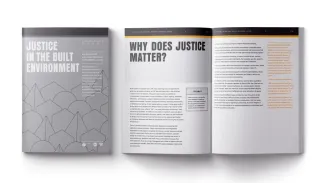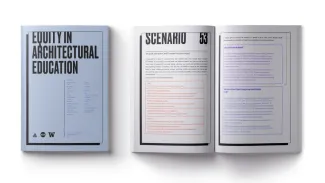Guides for Equitable Practice
The Guides for Equitable Practice use real-world-derived best practices, relevant research, and other tools to help foster equitable, diverse, and inclusive firm cultures and work environments. Increasingly, architects and design professionals will be called to lead efforts in finding solutions to many of our society’s most pressing issues. To meet these challenges, as well as the unknown ones ahead, we must have the talent, passion, and creativity of a diverse cohort of students, professionals, and leaders.

Building a more equitable future
The Guides for Equitable Practice, done in partnership with the University of Washington, the University of Minnesota, and The American Institute of Architects’ Equity and the Future of Architecture Committee (EQFA), are a vital part of AIA’s long-term commitment to lead efforts that ensure equity, diversity, and inclusion in architecture—that the architecture profession is as diverse as the nation we serve.
This collection includes an introduction, nine original guides, a glossary and two supplements which can be used to make the moral, business, ethical, and societal cases for equity in architecture and provide key insights to help individuals, firms, and the profession as a whole build equity in architecture.
Guide topics include intercultural competence, workplace culture, compensation, recruitment and retention, negotiation, mentoring and sponsorship, advancing careers, engaging the community, and measuring progress. Chapters include real-world-derived best practices, relevant research, and other tools to help you address a variety of employment and personnel issues about equity, diversity, and inclusion. The user-friendly layout and short, consumable sections are designed so you can find the content you need easily and quickly.

Introduction
The introduction provides historical context to the development of the Guides for Equitable Practice as well as an overview of the structure, approach and intended audiences that you will find woven throughout each chapter.
You'll learn essential terms like equity, diversity, inclusion and justice and how they are applied within the Guides as well as why equitable practice is important to the profession of architecture.
Intercultural competence—the ability to function effectively across cultures—affects performance at all organizational levels. This guide outlines the importance of increasing intercultural competence and recommends how to boost it while reducing bias against people with non-dominant identities.
You'll learn architecture’s challenges—including white male–dominated structures, the hero-architect trope, and extreme criticism—clash with collaborative practices, work-life balance, and practitioners’ diverse backgrounds. This guide covers questions to assess organizations’ intercultural competence levels along with concrete steps individuals and firms can take to create a level playing field and effect structural change.
This guide describes components of a strong, healthy workplace culture, details the field’s dominant patterns, and outlines the concept of architecture’s cultural iceberg—made up of objective culture (above the surface) and subjective culture (usually below the surface).
You’ll learn how workplace culture affects individuals, firms, and the profession—from retention to strategic planning and perception of the field. This guide also contains the legal aspects of harassment, including individuals’ responsibilities, questions to assess organizations’ workplace culture, and ways to improve your own organizations’ workplace culture.
Download Chapter 2: Workplace Culture >
Download ADA accessible Workplace Culture executive summary >
Architecture’s compensation issues arise from inequitable opportunities, valuation of work, and pay practices. Removing compensation gaps supports talent recruitment, development, and retention—along with the growth of individuals, firms, and the profession. This guide discusses wage disparities in architecture, including their origins and impacts. It establishes how compensation equity spans four dimensions (transparency, alignment, compliance, and fairness) and provides questions to consider when assessing organizations’ compensation.
You’ll also learn the legal factors related to unfair, discriminatory compensation and steps to increase compensation equity.
Attracting and retaining talent is vital for every firm and the profession as a whole. Given the importance of keeping quality employees, this guides outlines how to emphasize equitable practices during recruitment and retention. It covers how inequity affects employees, how to improve quality of life and address pinch points in the workplace, and ways to assess hiring and promotion bias and microaggressions.
Learn how to maintain a diverse workforce and compliance with laws governing recruitment and promotion. This guide includes concrete steps individuals and firms can take to increase fairness, build healthy pipelines, and boost retention.
Download Chapter 4: Recruitment & Retention >
Download ADA accessible Recruitment & Retention executive summary >
How can you ensure the negotiation process is collaborative, imbued with trust, and produces satisfying solutions for everyone involved, while maintaining equity? This guide outlines skills architects can develop to act inclusively and equitably during negotiations.
Learn how to act more equitably and ethically in building a healthy workplace, negotiating compensation on behalf of yourself or your firm, and navigating conflict. This guide includes ways to assess compliance with laws and how organizations fare in building equitable negotiation skills and integrity.
Mentorship and sponsorship, when one uses personal capital to promote a protégé, can prove crucial to individuals’ careers, and can help make workplaces more diverse and inclusive. These relationships can help individuals achieve power, influence, promotions, and increased compensation. You'll assess the qualities of being a mentor, mentee, sponsor, or protégé and the structure and effectiveness of mentorship programs.
You'll learn what equitable and inclusive mentorship and sponsorship look like, abiding by harassment and discrimination laws, maintaining ethical relationships, being an equitable mentor, mentee, and sponsor, and encouraging a culture of mentorship and sponsorship.
Download Chapter 6: Mentorship & Sponsorship >
Download ADA accessible Mentorship & Sponsorship executive summary >
It’s critical that responsibility for career advancement extends beyond individuals and is addressed with systems, policies, and a workplace culture that serves everyone. This guide details the importance of approaching career advancement as a shared responsibility between employee and employer; and examines equity issues in the workplace. It covers how social, cultural, and economic forces may steer individuals toward or away from certain pathways and how race and gender influence career progression.
You'll learn how firms and institutions can help support career advancement equitably by clarifying criteria for promotion, supporting networks, changing workplace culture from career ladder to lattice, and providing access to training and development.
Download Chapter 7: Advancing Careers >
Download ADA accessible Advancing Careers executive summary >
An architect's work affects communities, respectfully engaging with them and adopting solutions created in partnership is imperative. Such engagement leads to a more equitable built environment that flourishes. This guide notes that engaging communities has challenges resulting from years of inequitable practices in architecture and beyond, largely due to structural racism. With greater equity, the profession improves its impact and increases its value to society.
Download Chapter 8: Engaging Community >
Download ADA accessible Engaging Community executive summary >
True support of equity, diversity, and inclusion requires being able to measure progress. This guide outlines a number of measurable factors, including increased commitment to equitable practices from leaders, decrease in pay disparities, and less evidence of unconscious bias.
Download Chapter 9: Measuring Progress >
Download ADA accessible Measuring Progress executive summary >
Supplement: Justice in the Built Environment
AIA Guides for Equitable Practice supplementary edition
Beyond equity, diversity, and inclusion is a farther-reaching goal of justice: systems and processes that reverse long-standing injustices and that go beyond merely what is fair. In the creation of the built environment, justice can take the form of just processes (process that involve people who have experienced harm) and just outcomes (spaces that are safe, welcoming, and worthy of the beings who inhabit them).
This supplementary edition is intended to help designers convey the opportunities, benefits, and challenges of making justice a deliberate aim of the building process. It includes more hands-on interactive exercises, with worksheets and contextual timelines that can be used within project teams and with clients or partners.
Download Justice in the Built Environment >
Download Justice in the Built Environment executive summary >

Supplement: Equity in Architectural Education
AIA Guides for Equitable Practice supplementary edition
Office and school cultures feed and reinforce each other, and long-standing traditions, viewpoints, and biases in academia are strong. Attaining an increase in diversity and creating a welcoming culture for all within academia accelerates progress towards equity, diversity, and inclusion (EDI) in each sector of the profession.
This supplementary edition asserts that organizational culture is the basis for achieving goals of EDI in each sector of the profession. Together, the guides and this supplement reflect the many ways in which EDI goals and means can be integrated into professional practice and the academy alike.

Resources
Diversity in the Profession of Architecture Executive Summary—AIA (2016)
Summary of a survey that examined diversity in architecture, including perceptions of representation, factors impacting representation, reasons people leave the field, and job satisfaction.
Equity by Design Metrics: Key Findings for the 2016 Equity in Architecture Survey—Equity by Design (2016)
Summary of findings from the most recent Equity by Design's Equity in Architecture Survey, focusing on career dynamics (factors that affect perceptions throughout a career in architecture) and career pinch points (personal and professional milestones that affect career progression).
Parlour Guides to Equitable Practice—Parlour (2004)
A set of eleven guides to equitable practice focusing on gender equality in architecture in Australia: 1) Pay Equity, 2) Long Hours, 3) Part-Time Work, 4) Flexibility, 5) Recruitment, 6) Career Progression, 7) Negotiation, 8) Career Break, 9) Leadership, 10) Mentoring, 11) Registration.
Designing for Diversity: Gender, Race, and Ethnicity in the Architectural Profession—Kathryn H. Anthony (2001)
Surveys and interviews of four hundred architects looking at factors that lead to discrimination and how lack of diversity hurts the professions. Recommendations for ways to change. This is a key foundational text that remains relevant today.
Structural Inequality: Black Architects in the United States—Victoria Kaplan (2006)
Voices of twenty Black architects describing lifelong discrimination, marginalization, and pervasive racism in the profession, as well as their ways of navigating. Book addresses larger structural issues in architecture that currently make disadvantage inevitable.
American Association of People with Disabilities
The work of this advocacy organization includes information and resources on employment.
Diversity Matters—Vivian Hunt, Dennis Layton, and Sara Prince—McKinsey (2015)
Business case draws connection between diversity, performance, and increased profitability.
Only Skin Deep: Re-Examining the Business Case for Diversity—Deloitte Point of View (2011)
Aimed at organizations interested in the business case for diversity. Expands the demographic definition of diversity to include the diversity of ideas that comes from multiple backgrounds and experiences.
Out and Equal Workplace Advocates
Nonprofit dedicated to LGBTQ workplace equality.
Why Diversity Matters—Catalyst (2013)
Summary of Catalyst diversity studies makes the business case for diversity: improving financial performance, leveraging talent, reflecting the marketplace, building reputation, and group performance.
Researches many topics related to diversity, equity, inclusion in general and in relation to specific underrepresented groups. Resources to help companies better understand the issues; case studies and tools to help with implementing changes.
Provides tools and resources around the topics of women's leadership, families, and bias.
Offers many tool kits and worksheets for individuals and organizations to interrupt bias.
Wide array of tools to help organizations support, advance, and retain women employees: parallels in engineering and law.
CEOs Action for Diversity and Inclusion
CEO members pledge to advance diversity and inclusion. Actions taken by each company and the outcomes are cataloged.
Variety of articles with perspectives and insights on business and leadership topics. The company pioneered equitable practices.
Collection of tools and services to assist companies in data collection and analytics, including culture, employee engagement, and diversity.
Succinct articles summarize research on business topics including equity, diversity, and inclusion from a variety of sources.
Kirwan Institute for the Study of Race and Ethnicity
General overview of implicit bias and comprehensive annual reviews of current research into implicit bias across many fields.
Focused on empowering women to achieve their goals through organizing women's peer groups, public awareness, and education.
Research looks at issues, attitudes, and trends through social science research.
Society for Human Resource Management (SHRM)
Thorough array of resources for any size employer, tools include legal compliance and a variety of human resources topics.
We are actively engaged in multiple initiatives and goals that value EDI for people of all backgrounds.
This glossary defines terms related to equity, diversity, and inclusion (EDI) to establish a shared understanding of the Guides for Equitable Practice.
